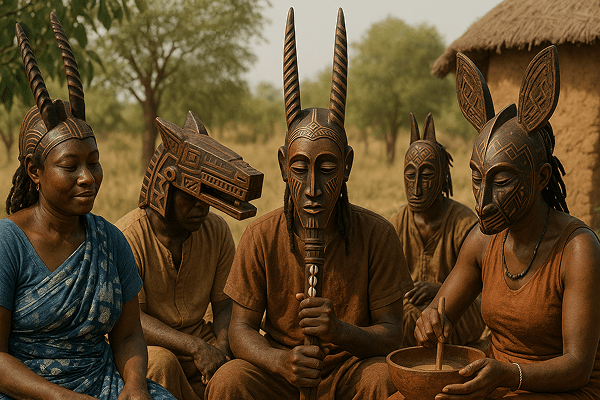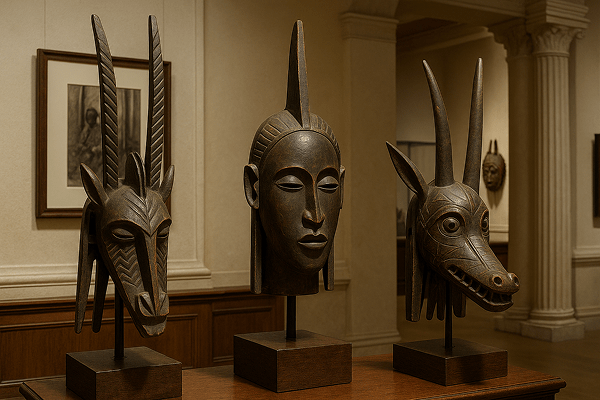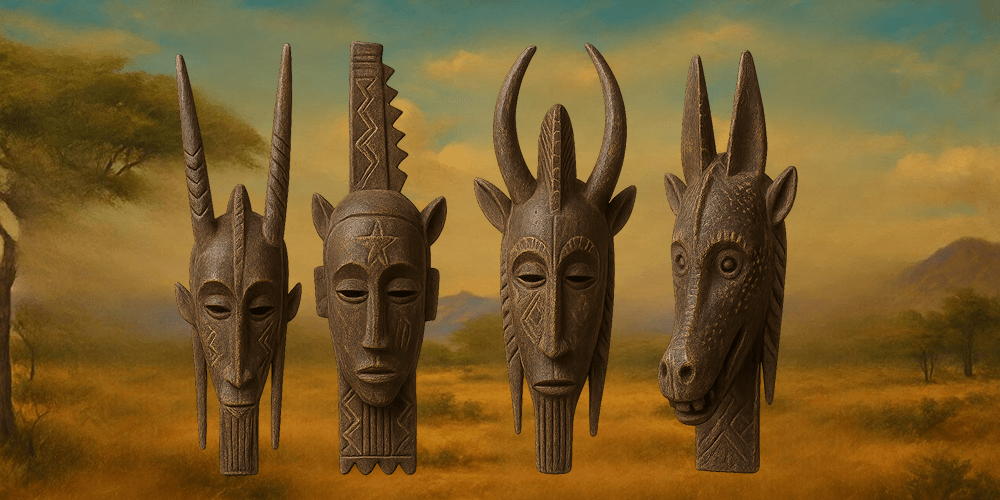Bambara Masks are among the most celebrated and visually arresting ritual artifacts in West Africa. Originating from the Bambara (Bamana) people of Mali, these masks are notable for their elongated forms, striking geometric features, and strong symbolic motifs. The masks often incorporate stylized representations of animals, such as antelopes, crocodiles, and hyenas, as well as abstract human faces. Characterized by bold patterns, horns, and crested headpieces, Bambara Masks are instantly recognizable and carry deep spiritual significance. The tradition of Bambara mask-making dates back centuries, deeply rooted in the animist and agricultural societies of the Niger River region.
Historical Origins: The Evolution of Bambara Masks
The history of Bambara Masks is intertwined with the origins of the Bambara people, who settled the Savanna regions of Mali over a millennium ago. The term “Bambara” refers to both the ethnic group and their language, and their mask traditions are among the oldest in the region. Historical evidence suggests that Bambara mask-making began as part of initiation rites and agricultural ceremonies, evolving alongside the rise of secret societies such as the Komo and the Chi Wara. Over time, the design and use of Bambara Masks expanded, influenced by trade, migration, and contact with neighboring cultures. Archaeological finds, oral traditions, and early travel accounts provide insight into the changing styles and functions of these masks. The evolution of Bambara Masks parallels that of other West African traditions, such as Dan Tribe Masks, which also use dramatic forms to convey spiritual and social meanings.
Cultural Significance and Symbolism: Meaning of Bambara Masks
Bambara Masks are central to the spiritual life of the Bambara people. Each mask type embodies a specific force of nature, ancestral spirit, or moral lesson. For example, the Chi Wara mask represents the mythical antelope believed to have taught humans how to farm, symbolizing fertility, hard work, and harmony with nature. Other masks are used in initiation ceremonies, funerals, and rites of passage, serving as mediators between the human and spiritual worlds. The elaborate designs and animal motifs are laden with meaning—horns may signify strength, zigzag patterns can denote the path of life, and vertical forms evoke the connection between earth and sky. Myths and legends surrounding Bambara Masks often recount the origins of the people, the wisdom of ancestral spirits, and the importance of communal values.

Materials and Craftsmanship: Creating Bambara Masks
Traditional Bambara Masks are carved from local hardwoods, such as acacia or kapok, known for their durability and spiritual resonance. The carving process involves shaping the mask with adzes and knives, followed by smoothing and detailing with chisels and sandpaper. Artisans often incorporate additional materials such as leather, metal, raffia, cowrie shells, and beads for decoration. The masks are painted with natural pigments—reds, blacks, whites, and ochres—each carrying specific symbolic meanings. Some masks feature intricate inlay work or burnished surfaces, while others are adorned with horns, crests, or animal figurines. Regional workshops may develop specialized techniques, resulting in a diverse array of mask styles within the broader Bambara tradition.
Functions and Use: Ritual and Social Roles of Bambara Masks
Bambara Masks are primarily used in ritual and ceremonial contexts. The most famous is the Chi Wara dance, in which performers wear antelope-shaped masks and enact the myth of agricultural knowledge. Other masks are used by secret societies, such as Komo, to impart spiritual protection, teach moral lessons, or enforce social discipline. Masks may also appear at funerals, harvest festivals, and public celebrations, functioning as agents of transformation, healing, and community cohesion. Over time, the use of Bambara Masks has adapted to changing religious beliefs and social structures, with some masks now appearing in national festivals, museums, and international exhibitions.
Regional Variations: Diversity Among Bambara Masks
Within the Bambara region, mask styles and meanings vary considerably. Northern masks may feature taller, more elongated forms, while southern examples emphasize animal motifs and vibrant coloration. Some villages develop unique mask types or rituals, often reflected in distinctive carving techniques or decorative patterns. Comparisons with other West African mask traditions, such as Dan Tribe Masks, highlight both the shared cultural roots and the distinctive innovations of the Bambara people. The resulting diversity is a testament to the richness and adaptability of African masking heritage.
Famous Examples and Collections: Where to See Bambara Masks
Significant examples of Bambara Masks are held in major museums, including the Musée du Quai Branly in Paris, the British Museum in London, and the National Museum of Mali. These institutions showcase Chi Wara antelope masks, Komo society masks, and other ritual objects, alongside documentation of their use and meaning. Private collections and galleries around the world also feature rare and antique Bambara Masks, some of which are considered masterpieces of African art. For those wishing to explore or acquire authentic pieces, online platforms such as toddmasks.com offer curated selections and educational resources.

Influence on Art and Culture: Bambara Masks in Global Creativity
Bambara Masks have had a profound influence on both African and global art. Their abstract forms, dynamic lines, and symbolic power have inspired modernist artists such as Picasso and Braque, as well as contemporary African painters and sculptors. In literature, film, and music, Bambara Masks are used to evoke themes of identity, transformation, and the interplay between tradition and innovation. The masks’ visual vocabulary has also found its way into fashion, architecture, and product design, helping to shape global perceptions of African creativity. The preservation and celebration of Bambara Masks play a vital role in maintaining cultural identity and fostering cross-cultural dialogue.
Modern Status and Preservation: Bambara Mask Traditions Today
Today, the tradition of Bambara mask-making is preserved by master carvers, local communities, and cultural organizations. Workshops, apprenticeships, and festivals help transmit techniques and stories to new generations. Modern adaptations include the use of new materials, innovative forms, and the incorporation of masks into contemporary theatre and visual art. Educational programs and museum exhibitions promote appreciation and understanding of Bambara Masks, ensuring their continued relevance in the 21st century. International collaborations and digital archives further support the documentation and revitalization of this remarkable tradition.
Collecting and Acquisition: The Market for Bambara Masks
The market for Bambara Masks includes both antique and contemporary pieces, available through museum shops, art galleries, and online platforms like toddmasks.com. Prices range widely depending on age, craftsmanship, provenance, and ritual significance. Collectors are advised to seek documentation of authenticity, understand the mask’s cultural context, and support ethical sourcing practices that benefit artisan communities. By valuing both the artistry and the spiritual meaning of Bambara Masks, collectors contribute to the preservation of African heritage.
